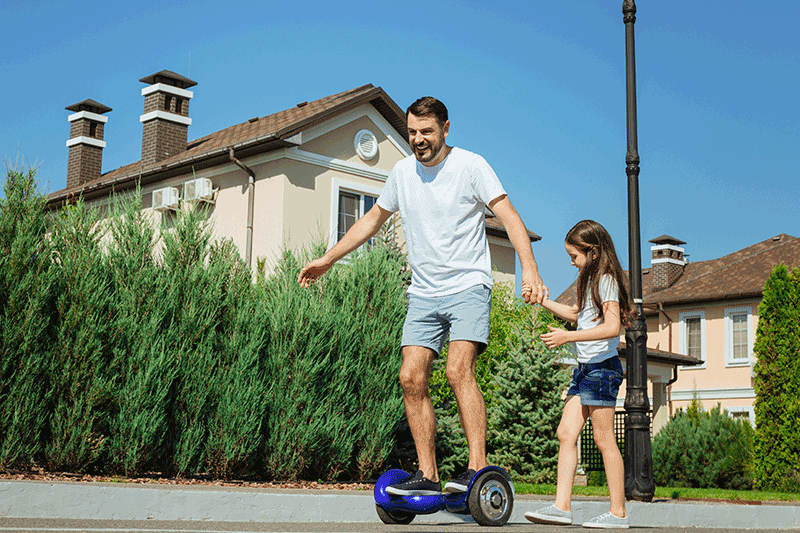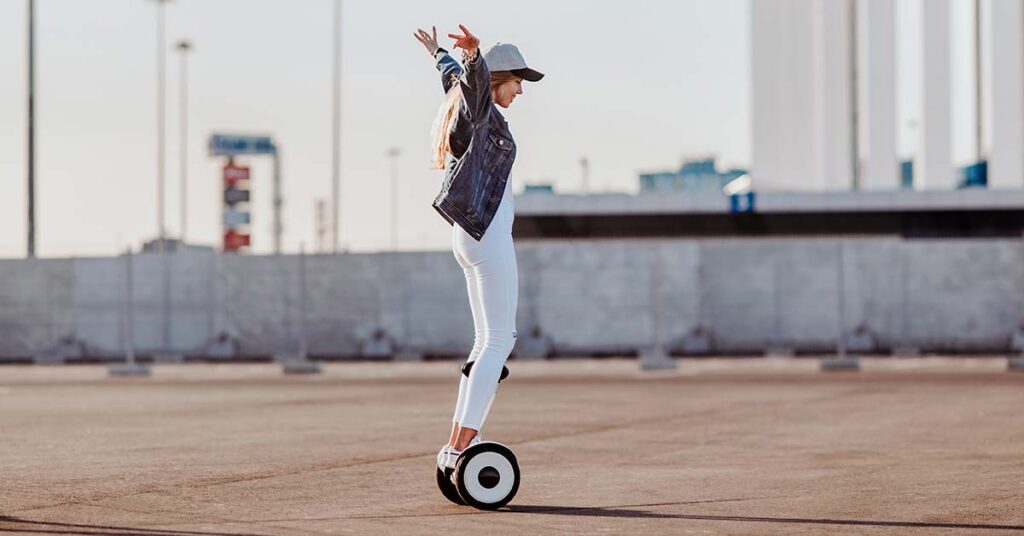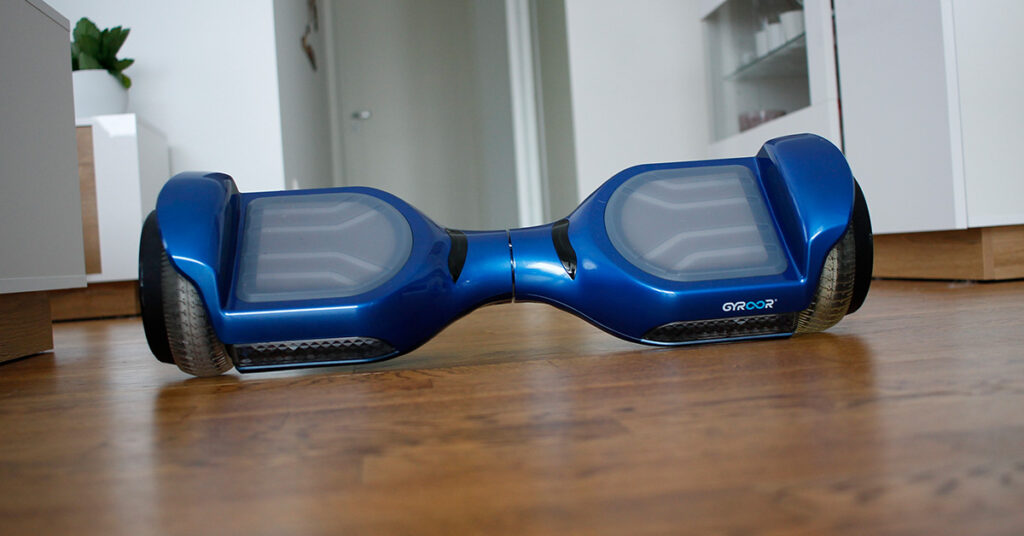We are often asked if the hoverboard weight limit is really that important? I would say that it is one of the most crucial things to keep in mind.
The vast offerings of hoverboards on the market make it tough for average consumers to gauge what is best for them. Hoverboards for children make great toys, but they have weight restrictions. Adults need hoverboards that are strong and have the power to take them up steep inclines.
What is the Weight Limit for a Hoverboard?

All hoverboards have a weight limit that should be in an obvious place on the deck. Hoverboards for both children and adults will have a weight limit sticker. How much weight can a hoverboard hold depends on several factors:
- To whom is the hoverboard meant for
- Wheel size
- Build materials
A child hoverboard will have a weight limit of up to 120 pounds (55 kg).
Adult hoverboards with 8.5-inch wheels may support 265 pounds(120 kg). Hoverboards with 6.5-inch wheels should support 220 pounds (100 kg). It is better to stay well within these limits if you want your board to last.
An adult hoverboard max weight may go up to 420 pounds (190 kg), though this tends to be for top-end boards with 10-inch wheels. The best way to be sure about the hoverboard max weight is to look for the label on the box and the board.
So far, I have only seen one hoverboard with a weight limit of over 300 lbs – Swagtron Outlaw T6.
What is the weight limit for a hoverboard by wheel size?
- 4.5″ – 120 lbs
- 6.5″ – 220 lbs
- 8.5″ – 260 lbs
- 10″ – 260-420 lbs
If you are looking for a hoverboard with a high weight limit, see our list of best hoverboards for heavy adults or best off-road hoverboards.
OneWheel weight limit?

OneWheel has two models of one-wheeled hoverboards – Pint and XR.
The suggested weight limit for OneWheel Pint is 250 lbs.
OneWheel+ XR has a weight limit of 275 lbs.
What is the Purpose of the Hoverboard Weight Limit?
The hoverboard weight limit is in place to protect the board and the rider. The manufacturers will put their hoverboards through various tests. These tests include trying to figure out the stress the board can take before breaking.
A hoverboard chassis often consists of ABS and aluminum. The higher the weight limit, the more aluminum will take over from ABS as the key material. If you overstress a hoverboard, you can bend or even snap the chassis.
Self-balancing boards will struggle to cope with a heavy rider and will not be able to counteract their movements. Heavier riders take more energy to get up an incline. The weight limit is also in place to protect the battery and the motor from overloading.
What Happens if I Exceed the Hoverboard Weight Limit?
You have a much greater chance of having an accident on a board that is not suitable for your weight. Surpassing the load limit of your hoverboard will make the ride unstable and dangerous. The braking action may not be adequate for an overweight passenger.
Hoverboards with lower weight limits have smaller wheels, so you may find that your board struggles or fails to turn. The wheels may also buckle or snap while trying to turn with an overweight passenger.
If you are a small amount over the limit, you will still be able to ride the board, but you may cause lasting damage. A couple of pounds sounds small, but it will speed up fatigue. Excessive pressure on the bolts, motor, and plastic footplates will shorten the lifespan of the board.
Is there a Minimum Weight for the Hoverboard?

Hoverboard weight requirement also includes a minimum weight restriction. This function ensures the proper working of the controls and self-balancing sensors. Most hoverboard manufacturers set 44 pounds (20 kg) as the lowest weight for their passengers.
You could cheat by adding weight to the child, but this is inadvisable and dangerous. This limit is also a broad method of preventing children younger than four or five from using a hoverboard. All young children should wear a helmet and pads.
Some hoverboards have weight minimums as high as 70 pounds (32 kg) – this is often for professional teenage and adult riders. Manufacturers will write the weight or age minimum on the packaging or in the manual.
What Happens with the Hoverboard if I am Below the Required Weight?
Riders that do not meet the minimum weight will not be able to ride their boards. Safety sensors within the hoverboard prevent it from operating. This stops young children from using them, and it also prevents accidental activation if an object falls onto the footplate.
Adults should also not try to ride with their child between their legs, as this will unbalance the board and end in tears for both passengers. Adults should not have a problem with the minimum, though they should still avoid resting objects on the board.
How Much Does a Hoverboard Weigh?
The electric motors are the heaviest components, and a child’s hoverboard will have a small motor. A child’s hoverboard will weigh a little as 18 pounds (8 kg), depending on the battery and motor size. Though 25 pounds is the standard weight for most children’s hoverboards.
Adult hoverboards range anywhere from 18 pounds to 30 pounds. Wheel size, larger batteries, and stronger frames all add to the weight of the board. A high-end off-road hoverboard with 10-inch wheels will weigh over 30 pounds (14 kg).
What Size Hoverboard Should I Get?

Consider your ability and where you intend to use it. Are you going to take the board to work or use it on the weekends in the park? Some hoverboards cope better in the rain than others – larger and wider tires will help.
Think about your weight and the weight of any luggage you may have. A full backpack and your clothing can add tens of pounds to the total weight. Calculate your hoverboard needs by adding 20 pounds to your weight – this gives you some leeway.
Once you have your total weight, you can slim down the options further by looking at your experience with hoverboards. First-time riders may want to go for the smallest motor size for their weight limit. A heavier rider will have to get a larger board with a more powerful motor.
Hoverboard Weigh-In
A hoverboard with large wheels is easier to manage, and it will cope better with uneven surfaces like roads or sidewalks. The hoverboards with large motors will draw more power. If you are planning to commute on it, make sure that the hoverboard’s battery gives you the range to do so. Riders wanting to power uphill should also aim for boards with larger batteries.
Conclusion
Buying a hoverboard not rated for your weight will be a headache from the beginning. There are people that feel they can get away with smaller boards, but it is not worth it. Weight limits on hoverboards are there to provide you with a safe and reliable ride.
If you have a question about hoverboard weight limits, please add a comment down below.

The founder and the editor-in-chief of the Electric Wheelers blog. With a previous background in IT, sales, and video editing, he has now established himself as a micromobility expert.
He bought his first e-scooter over 5 years ago and since then has owned dozens of e-scooters and e-bikes. His deep understanding of the technical aspects, coupled with a keen eye for market trends, enables him to provide insightful and reliable content.
His commitment to promoting sustainable and efficient urban mobility solutions has made him a respected voice in the community of eco-friendly transportation enthusiasts.




